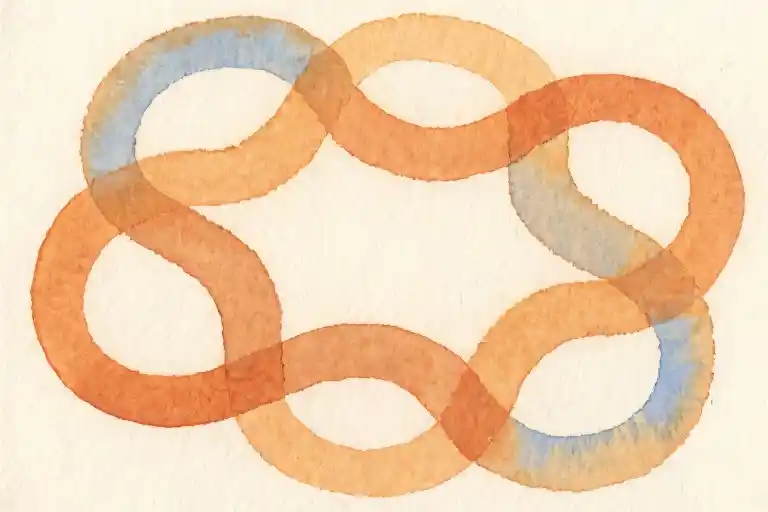The last time I felt those fluttering sensations in my stomach, I mistook them for love. November 2021—that crisp autumn evening when he showed up unexpectedly with takeout from my favorite Thai place. My body reacted before my brain could process: quickened pulse, clammy palms, that peculiar lightness in the chest we’ve all learned to call ‘butterflies.’ What I didn’t know then was how closely these symptoms mirrored the physical manifestations of anxiety.
We romanticize these bodily reactions as proof of connection, but neurobiology tells a more complex story. The same adrenaline that makes your hands shake during a first date also floods your system when facing danger. My body wasn’t celebrating love—it was sounding alarms about inconsistencies I refused to acknowledge. His texts that came in erratic bursts (three days of obsessive messaging followed by radio silence), the way he’d reference future plans then act surprised when I remembered them—these weren’t quirks of a busy professional, but the calculated oscillations of emotional manipulation.
By the time I recognized the pattern, my nervous system had already developed its own vocabulary. The ‘butterflies’ transformed into something sharper—a persistent ache beneath my ribs whenever his name appeared on my phone. Still, I clung to those early moments, the way trauma bonds trick us into cherishing the hooks that keep us tethered to harm.
Then came Thane Rivers. Not as some grand romantic revelation, but as an algorithm’s whim—a six-foot-four Scandinavian woodworker whose Instagram featured equal parts axe-throwing tutorials and close-ups of his terrycloth dinosaur pajamas. There was something disarmingly human about the contrast: this Viking-bearded man earnestly demonstrating how to build a canoe while dressed like a sleep-deprived preschooler. For the first time in months, I felt my body react without dread.
What began as comic relief became an unexpected lesson in authenticity. Thane’s ridiculous sleepwear (which he unapologetically tagged #sponsored) carried more transparency than my ex’s entire romantic repertoire. Here was someone who didn’t confuse vulnerability with weakness—who could post a sponsored pajama ad one minute and a raw video about his divorce the next. That’s when I realized: real connection shouldn’t require your body to sound alarms.
Sometimes the most profound truths come dressed in absurd packaging. My journey from mistaking anxiety for affection to appreciating a stranger’s silly pajama ads wasn’t the healing narrative I expected. But trauma recovery rarely follows predictable arcs—it’s more like watching a Viking in cartoon-print fleece remind you how to breathe again.
When Butterflies Bite Back
That fluttery feeling in your stomach – we’ve all been taught to call it butterflies. The universal sign of romantic attraction, the physical proof of chemistry. Except when it’s not. When it’s actually your body sounding the alarm in Morse code, but you’ve misread the dots and dashes as love letters.
I remember pressing my palm against my abdomen during those early months, marveling at the electric buzz beneath my skin whenever he texted. My friends would coo about how lucky I was to feel such intense connection. None of us realized my nervous system wasn’t celebrating – it was white-knuckling the emergency brake.
Neurologists will tell you the physiological responses to infatuation and anxiety are nearly identical. Increased heart rate? Check. Shortness of breath? Present. Sweaty palms and digestive unrest? Absolutely. Your body can’t distinguish between standing before someone breathtaking and standing before something threatening – both scenarios trigger the same cocktail of adrenaline and cortisol.
In healthy relationships, these sensations gradually mellow into something warmer and steadier. But in toxic dynamics, the spikes keep coming. You mistake the rollercoaster for the ride of your life, not realizing constant butterflies might mean you’re actually allergic to the relationship.
Dr. Elaine Aron’s research on highly sensitive persons shows we’re particularly prone to this confusion. Our nervous systems light up like pinball machines at the slightest stimulus – whether that’s a breathtaking sunset or emotional whiplash from inconsistent affection. The same intensity that lets us experience joy in technicolor can also paint danger in deceptively bright hues.
I started keeping a physical sensations journal after the breakup. Noting how my body reacted to:
- His unpredictable texting patterns (cold sweat between shoulder blades)
- Backhanded compliments (sharp inhale followed by stomach drop)
- Future-faking promises (racing pulse with delayed crash)
Pattern recognition became my Rosetta Stone. Those weren’t love’s sweet tremors – they were my cells screaming in a language I’d never been taught to understand. The real tragedy? How our culture romanticizes precisely these warning signs as passion’s proof.
Next time you feel those familiar flutters, pause. Ask yourself:
- Does this feeling come with safety or scarcity?
- Is my body preparing to receive joy or brace for impact?
- Are these wings beating toward something or away from something?
True connection should feel like coming home, not walking a tightrope. Though I suppose even that realization comes with its own stomach-dropping moment – when you finally understand how thoroughly you’ve mistaken falling for flying.
The Disappearing Act
He showed up at my doorstep at 3:17 AM with a still-warm croissant from that 24-hour French bakery across town. The butter scent clung to his jacket when he hugged me, his heartbeat audible against my ear. ‘Couldn’t sleep thinking about you,’ he murmured into my hair. This became our normal – extravagant gestures appearing like sudden summer storms, drenching me in attention before vanishing without warning.
For three weeks straight, my phone buzzed constantly with messages written in his particular shorthand: ‘U r my sunrise’ at dawn, ‘Tell me 1 thing u noticed today’ during lunch breaks, voice notes humming with songs he claimed I inspired. Then came the first disappearance. Seventy-two hours of radio silence ended with a single text: ‘Miss u like crazy. Emergency work trip. Details later.’ No explanation ever came, just another bouquet (peonies this time) delivered with a note promising ‘next time will be different.’
I started tracking the patterns like a meteorologist predicting storms. The longest stretch of attention lasted 11 days; the cruelest disappearance coincided with my birthday. By November, the temperature drops mirrored our interactions – brief flashes of warmth swallowed by increasingly long cold fronts. My friends began calling it ‘the weather report’ when I’d analyze his latest message: ‘He used three exclamation points today, maybe this time…’
What fascinates me now isn’t his behavior but mine. How I learned to ration his affection like emergency supplies. How my body developed its own warning system – stomach acid rising when his texts turned vague, shoulders tensing hours before his typical ghosting periods. The greatest trick emotional manipulators pull isn’t making you love them; it’s making you believe the crumbs they scatter are feasts.
Winter arrived early that year. I remember standing at my window watching the first snow dust the sidewalk where he\’d once waited with breakfast, realizing the coldest places aren’t created by absence, but by the memory of warmth that was never really there.
The Switch
It happened with the finality of a light switch flicked off in an empty room. One moment I was cycling through the familiar fantasies – him showing up at my door with apologies, us rebuilding something real this time – and the next, the entire emotional circuit went dark. Not with drama, but with eerie quietness, like when refrigerator hum stops and you only notice because the silence feels wrong.
This wasn’t the gradual fading I’d experienced after previous breakups. No nostalgic pangs when hearing our song, no involuntary comparisons when friends showed off their partners. My brain had erected one of those velvet ropes they use at crime scenes, cordoning off entire neural pathways labeled Romantic Interest: Do Not Cross. The complete absence of sexual desire surprised me most. For years I’d considered high libido part of my identity, yet now the very concept felt as foreign as explaining TikTok trends to my grandmother.
Several possibilities emerged during my late-night research spirals:
- Temporary shutdown – My therapist compared it to a computer entering safe mode after system failure. The psyche’s way of preventing further damage while doing repairs.
- Asexuality spectrum – Reading about graysexuality felt like trying on glasses with slightly wrong prescriptions; almost but not quite fitting my experience.
- Reorientation – That Instagram algorithm kept showing me Thane Rivers’ content for reasons beyond pajama marketing genius. His comments section overflowed with women and nonbinary folks sharing similar post-trauma awakenings.
What helped was the “Desire Thermometer” exercise from a trauma recovery workbook:
- Boiling (100°F): Physical reactions to love bombing (racing heart, obsessive thoughts)
- Simmering (80°F): Compulsive fantasizing during no-contact periods
- Room Temp (70°F): First months after final confrontation
- Chilled (40°F): Current state – not unpleasant, just… absent
The visualization revealed an unexpected comfort in this emotional winter. Where I’d expected barrenness, I found clarity – like seeing the bones of trees after autumn strips away their leaves. Maybe the switch didn’t turn something off so much as it stopped the noise, letting me hear subtler frequencies I’d mistaken for silence.
The Viking in Clingy Pajamas: When Absurdity Heals
Somewhere between deleting his number for the twelfth time and Googling “can trauma turn you asexual,” my phone served me Thane Rivers. Instagram’s algorithm, that mysterious digital therapist, decided what I needed wasn’t another article about healing but a 6’4″ Scandinavian man wearing dinosaur-print pajamas that clung to his thighs like saran wrap.
His profile was a masterclass in cognitive dissonance: #VikingLifestyle captions over photos of him baking cinnamon rolls, axe-throwing tutorials intercut with stories about his emotional support houseplant. The pajamas became his signature – those ridiculous, intentionally-too-small sleepwear pieces he’d wear while doing deadlifts or reading Nordic poetry.
What fascinated me wasn’t the thirst traps (though the man did understand lighting), but the marketing genius beneath them. His “Barely Contained” pajama line walked the perfect line between parody and desire:
- The Fabric of Absurdity: 100% organic cotton marketed as “tested on actual Vikings” (his uncles in Oslo)
- Size Chart Honesty: “If you can breathe comfortably, you’ve bought the wrong size”
- Cultural Whiplash: Norse mythology quotes paired with care instructions like “Wash cold with your dignity”
For someone freshly disillusioned with performative masculinity, watching Thane weaponize ridiculousness felt revolutionary. Where my ex had used intensity as manipulation, Thane used humor as disar… (continued in next week’s newsletter – his PR team won’t let me reveal the pajama patent drama yet)
When Butterflies Aren’t What They Seem
That fluttery feeling in your stomach – we’ve been conditioned to call it butterflies, to romanticize it as the universal sign of falling in love. But what if your body’s trying to tell you something entirely different? My last experience with these so-called butterflies came in November 2021, standing across from someone I believed was my boyfriend. Except now I understand those weren’t wings of excitement beating inside me – that was my nervous system sounding the alarm about his coercive behavior.
For months after he vanished (with the same abruptness he’d entered my life), I’d indulge in reconciliation fantasies that brought back those familiar stomach flutters. The summer heat finally burned through that illusion when I reached out and he revealed our ‘relationship’ had never been more than casual entertainment to him. What surprised me most wasn’t his cruelty, but how instantaneously my romantic and sexual desires evaporated afterward. Like flipping a switch.
The Disappearing Act of Desire
This sudden emotional freeze fascinated me. Research suggests our brains often mistake anxiety for attraction – both trigger adrenaline, sweaty palms, that telltale stomach swoop. My body had been waving red flags I’d stubbornly misinterpreted as heart emojis. The realization left me equal parts relieved and unnerved: if I couldn’t trust my own physiological responses, how would I ever recognize real connection?
Enter Thane Rivers – Instagram’s most improbable Viking, whose genius marketing involves strategically clingy pajama pants (seriously, whoever designed those deserves a raise). There’s something beautifully subversive about a man who weaponizes comfort wear instead of emotional manipulation. His unapologetic silliness became my unexpected compass for recalibrating what actually deserves that fluttery feeling.
Rewriting Your Body’s Dictionary
So here’s what I wish I’d known earlier:
- Toxic butterflies feel like impending doom dressed in glitter
- Healthy attraction includes calm alongside excitement
- Trauma responses often masquerade as desire long after the danger passes
I’m learning to translate my body’s signals without the romantic filter society insists we use. Maybe your version looks different – that’s why I’d love to hear your stories in the comments. What did your ‘butterflies’ turn out to be?
For those wanting deeper reflection, I’ve created a free [Manipulation Red Flags Checklist] – because nobody should need a Viking in pajamas to recognize their worth. (Though if you’re curious about Thane’s sleepwear empire… well, that’s a story for another day.)





